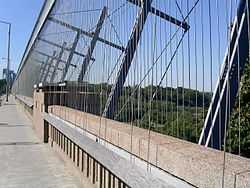Suicide barrier

A suicide barrier is a barrier on a bridge (often a so-called suicide bridge known for suicide attempts), observation deck or other structure designed to prevent people from attempting suicide by deliberately jumping. Many suicide barriers are tall and fence-like. But suicide nets, which extend horizontally below the bridge and preserve views outward, have been used on the Bern Muenster Terrace in Bern, Switzerland and the Cornell University campus in Ithaca, New York. A suicide net is currently being proposed for the Golden Gate Bridge as well.
Comprehensive suicide barriers can be very expensive: Planners estimate that the barrier proposed for the Golden Gate Bridge will cost $40 to $50 million.[1] Aesthetic concerns are also commonly raised: heavy fences are often unsightly, detracting from the appearance of the bridge and the view from the bridge itself.
The most intense debate, however, is on the subject of whether a suicide barrier will actually save lives. Studies have shown that well-designed suicide barriers not only stop people from jumping at a particular site, but also decrease the overall suicide rate in the surrounding area.[2][3] Another set of data comes from a barrier built in 1983 on the Augusta River Bridge in Maine, where 14 people had previously jumped to their deaths. The barrier eliminated suicides from the bridge. A study of suicides in the area during the two decades before and after installation of the barrier found no increase in jumping from nearby high structures, and the city of Augusta had a greater reduction in its suicide rate than the reduction seen in the surrounding area during the same period.[4]
The largest study to observe the effects of a barrier, published in the British Medical Journal in 2010,[5] showed that after a barrier went up at the Bloor Street Viaduct, the rate of jumping from other bridges in Toronto increased and there was no decrease in the overall jumping rate, although there was a decrease in the overall suicide rate in Toronto. The study also mentions that suicide barriers may not be effective if there are comparable jumping points nearby or if the structure is not a strong suicide magnet.
Additionally, while studies have shown easy access to guns has an effect on a region's suicide rate, two studies that looked at regions with access to "suicide" or "landmark" bridges found that the overall suicide rates in these places were not higher than average, despite higher than average jumping suicide rates.
Some believe suicide barriers will save some lives, even if the number of lives saved cannot be statistically accounted for. They point to the barrier at the Duke Ellington Bridge in Washington D.C. After a barrier went up on that bridge, cutting the suicide rate there significantly, the number of suicides from a nearby bridge did not increase. However, as one author of this study pointed out, there was no reason to believe that suicide attempters would be limited to these two bridges.
Others have argued that barriers may actually cost lives,[6] especially when they are put up in high traffic areas, where some suicidal people have been stopped by bystanders in the past.
Even if suicide barriers do not save lives, they offer benefits in certain situations. Suicide barriers are commonly installed on pedestrian bridges that run over train tracks and highways to prevent injury and trauma to those below.
References
- ↑ "Golden Gate Bridge Physical Suicide Deterrent System Project". Retrieved 2008-10-02.
- ↑ Bennewith O, Nowers M, Gunnell D: Effect of barriers on the Clifton Suspension Bridge, England, on local patterns of suicide: implications for prevention. Br J Psychiatry 2007; 190:266–267
- ↑ Reisch T, Michel K: Securing a suicide hot spot: effects of a safety net at the Bern Muenster Terrace. Suicide Life Threat Behav 2005; 35:460–467
- ↑ http://ajp.psychiatryonline.org/article.aspx?articleID=101197
- ↑ British Medical Journal
- ↑ cost lives